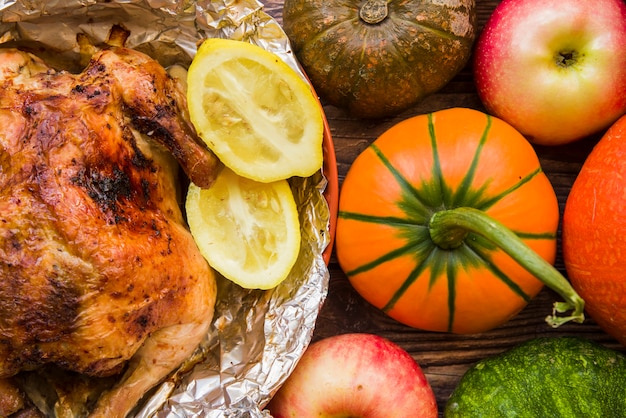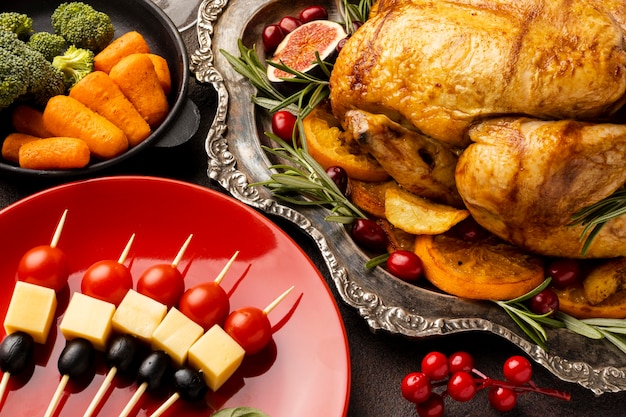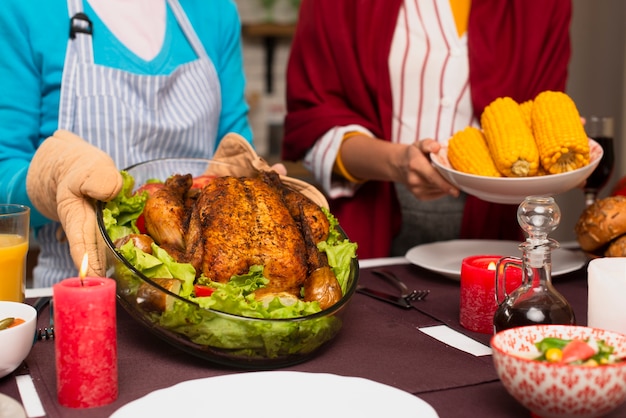(Part 1) Getting to Know Your Bird: Turkey Anatomy and Size

A. Turkey Anatomy: Where the Temperature Really Matters
Think of a turkey as a culinary puzzle. Each piece needs to be cooked just right, and understanding the anatomy of this bird is crucial. The thickest part, the thigh, needs to hit a specific temperature to ensure that even the leanest part, the breast, is cooked through.Imagine a juicy, golden-brown turkey, glistening with savory goodness. That's the goal, right? But achieving that perfection relies on mastering the internal temperature of the thigh. It’s like the conductor of the culinary orchestra, ensuring all the different parts of the turkey reach their peak flavour potential.
B. Turkey Size: A Big Bird Needs More Time
Size matters! It's not just about the turkey's weight, but also its shape. A petite bird cooks much faster than a large, plump one. Just like baking a cake, a larger volume takes longer to heat through.I once tried to cook a 20-pound turkey in the same time I normally cooked a 10-pound bird. Let's just say it was a disaster. The breast was dry, the thighs were still raw, and the family was left wondering if we were having dinner or a culinary experiment. That's why I now rely on a trusty meat thermometer, which takes the guesswork out of cooking time.
(Part 2) Choosing Your Method: Oven or Roaster?

A. oven roasting: The Classic Way
The traditional oven roasting method is a classic for a reason. It's simple and reliable, giving you a consistently cooked turkey. Just pop it in the oven, set the timer, and let it do its thing.One thing I've learned is that elevating the bird on a rack is a game-changer. It allows air to circulate around the turkey, which helps it cook more evenly and prevents the breast from drying out. I've seen the difference, and it's truly remarkable.
B. Roasting in a Roaster: Even Cooking and Less Mess
A roasting pan with a lid is like having a built-in shield against splatter, making cleanup a breeze. The enclosed environment also keeps the turkey moist and tender. Plus, you can roast vegetables alongside the turkey, adding depth of flavour and making it a one-pot wonder.Think of it as a multi-tasking marvel! You're not just cooking a turkey, you're creating a delicious symphony of flavours. The aroma of roasted vegetables mingling with the aroma of turkey is something special. It truly transforms the whole experience.
C. Roasting with a Basting Method: Moisture is Key
Basting is the secret to a truly succulent turkey. It's like giving the bird a spa treatment while it's cooking, ensuring it stays moist and juicy. You can use melted butter, oil, or even broth. The key is to be consistent and baste it every 30-45 minutes.It might seem like a lot of effort, but trust me, it’s worth it. You'll be rewarded with a turkey that melts in your mouth. It's like magic! The basting technique transforms a simple roast into a gourmet experience.
(Part 3) The Critical Temperature: It's Not Just About the Bird

A. The Safe Zone: What’s the Right Temperature for Turkey?
Safety first, always! The Food Standards Agency recommends cooking turkey to an internal temperature of 74°C (165°F). This ensures the bird is thoroughly cooked and safe to eat.Think of it as a culinary safety net. This is not the time to experiment or cut corners. We want to enjoy our feast without any worries about foodborne illnesses.
B. turkey breast: The Leanest Part
The breast is like the athlete of the turkey world – it’s lean and powerful, but can dry out easily if overcooked. Aim for an internal temperature of 71°C (160°F) for the breast to ensure it stays juicy and tender.Remember, you can always cook the breast a bit longer, but it's harder to reverse overcooking. So, err on the side of caution and check the temperature regularly.
C. turkey thigh: The Temperature to Watch
The thigh is the thickest, meatiest part of the turkey. It takes longer to cook, so aim for an internal temperature of 82°C (180°F) for the thigh. This ensures the entire bird is cooked through, including the breast.Think of the thigh as the heart of the turkey. It’s where the flavour concentrates. When it's cooked to perfection, it's a symphony of taste and texture.
D. Temperature Monitoring: Your Best Friend
A meat thermometer is your most valuable tool. It's like a culinary detective, ensuring your turkey is cooked to perfection. Insert it into the thickest part of the thigh, making sure it doesn't touch the bone.Remember, looks can be deceiving. Just because the turkey looks cooked doesn't mean it is. A meat thermometer is the only way to know for sure.
(Part 4) Understanding the Cooking Times: A General Guide
A. Cooking Time Estimation: Just a Starting Point
Estimating cooking time is a good starting point, but it's crucial to remember it's just a guide. The weight, shape, and cooking method all influence how long the turkey needs to cook.Remember, time is not a constant. It's a variable that can change depending on the circumstances. So, always use a meat thermometer to ensure your turkey is cooked through, regardless of the estimated cooking time.
Here's a general estimate for a whole turkey:
- Small (5-8 pounds): 2-3 hours
- Medium (8-12 pounds): 3-4 hours
- Large (12-16 pounds): 4-5 hours
- Extra Large (16-20 pounds): 5-6 hours
B. Adjusting for Altitude: A Higher Altitude Means Longer Cooking Time
If you live in a high-altitude area, the thinner air means that water boils at a lower temperature. This affects the cooking process, making your turkey take longer to reach the desired temperature. Increase the cooking time by 10-15% if you're cooking at an altitude above 5,000 feet.Think of it like this: Higher altitude is like adding a challenge to your cooking. It's like climbing a mountain. You need to exert more effort to reach the peak. So, adjust your cooking time accordingly.
(Part 5) The Resting Time: Don’t Skip This Step
A. Let the Turkey Rest: Important for Juiciness
After your turkey has reached the desired temperature, don't be tempted to carve it immediately. Let it rest for at least 30 minutes, covered with foil. This allows the juices to redistribute throughout the bird, resulting in a more succulent and flavorful turkey.Think of this as a culinary massage. The turkey needs time to relax and settle before you start carving. It's like giving it a chance to recover from its time in the oven.
B. How to Rest Your Turkey: Cover it with Foil
Tenting the turkey with foil keeps it warm and moist. It creates a cozy environment for the juices to settle back into the meat. Imagine the turkey tucked in a cozy blanket, waiting for the grand finale.Remember, patience is a virtue, especially when it comes to turkey. A few minutes of waiting can make all the difference in the world.
(Part 6) turkey doneness: Signs to Look For
A. The Internal Temperature: Your Most Reliable Indicator
The most reliable way to tell if your turkey is cooked is by checking the internal temperature with a meat thermometer. The temperature should reach 74°C (165°F) in the thickest part of the thigh.Think of the thermometer as your culinary compass. It’s your guide to ensuring your turkey is safe and delicious.
B. Other Signs: The Turkey’s Appearance and Juice
While the thermometer is the ultimate guide, there are other visual cues that can indicate the turkey is cooked:- The skin should be golden brown and crispy. This is a sign that the turkey has been roasted to perfection.
- The juices should run clear, not pink or red. This indicates the turkey is cooked through.
- The turkey should be firm to the touch. This means the meat has cooked and firmed up.
Remember, these visual cues are just indicators. Always use a meat thermometer to be sure. It’s better to be safe than sorry!
(Part 7) Turkey Troubleshooting: Addressing Common Problems
A. Dry Breast: The Dreaded Dilemma
A dry breast is a common issue, especially with large turkeys. But don't fret, there are ways to prevent it:- Baste the breast regularly with butter, oil, or broth. This adds moisture and flavour, keeping the breast tender.
- Use a turkey roasting rack to allow for better airflow. It’s like giving the breast a personal fan, ensuring it cooks evenly.
- Don’t overcook the turkey. Remember, you can always cook it a little longer, but it’s harder to reverse overcooking.
If you find yourself with a dry breast, there are ways to salvage it. You can slice the breast thinly and serve it with gravy or sauce. Or, you can use it in a dish like turkey salad.
B. Undercooked Turkey: A Safety Concern
This is a serious problem, as undercooked turkey can carry harmful bacteria.- Always use a meat thermometer to check the internal temperature. It’s your best defense against foodborne illness.
- Cook the turkey to the recommended temperature of 74°C (165°F). No exceptions!
- If the turkey is undercooked, return it to the oven and cook it for longer. It's better to be safe than sorry.
(Part 8) turkey leftovers: Making the Most of Your Bird
A. Storing Turkey Safely: Refrigeration is Key
Leftover turkey should be stored in the refrigerator within two hours of cooking. Place it in airtight containers to prevent flavour loss and contamination. Refrigerate it for up to three days.Think of this as a culinary time capsule. You're preserving the flavours of your feast so you can enjoy them again later.
B. Reheating Turkey Safely: Avoid food poisoning
To reheat turkey safely, reheat it to an internal temperature of 74°C (165°F). This can be done in the oven, microwave, or on the stovetop.Remember, when it comes to food safety, it's better to be overly cautious than to take any chances.
C. Creative Leftover Dishes: Beyond turkey sandwiches
Don’t just stick with turkey sandwiches! Get creative with your leftovers. Here are some ideas:- turkey pot pie: A hearty and comforting dish that's perfect for a cold day.
- turkey soup: A warm and flavorful way to use up leftover turkey. You can add vegetables, herbs, and spices to create a unique flavour profile.
- Turkey salad: A refreshing and light option that's perfect for a lunch or picnic.
Let your imagination run wild! The possibilities for leftover turkey are endless.
(Part 9) turkey recipes: Inspiring Your Next Feast
A. Classic Roasted Turkey: A Time-Honored Recipe
This is a simple and reliable recipe that will always please a crowd.Ingredients:
- 1 whole turkey, about 12-14 pounds
- 1 tablespoon olive oil
- 1 teaspoon salt
- 1/2 teaspoon black pepper
- 1/4 cup fresh herbs (such as thyme, rosemary, sage)
Instructions:
- Preheat oven to 190°C (375°F).
- Rinse the turkey inside and out, pat dry, and place in a roasting pan.
- Rub the turkey with olive oil, salt, pepper, and herbs. This will create a flavorful crust and enhance the natural flavour of the turkey.
- Roast the turkey for about 3-4 hours, or until the internal temperature reaches 74°C (165°F) in the thickest part of the thigh.
- Let the turkey rest for at least 30 minutes before carving. This will allow the juices to redistribute throughout the bird, resulting in a more succulent and flavorful turkey.
B. Spiced Turkey with Cranberry Sauce: A Festive Twist
This recipe adds a touch of warmth and sweetness to your turkey. It's perfect for a holiday meal or any festive occasion.Ingredients:
- 1 whole turkey, about 12-14 pounds
- 1 tablespoon olive oil
- 1 teaspoon salt
- 1/2 teaspoon black pepper
- 1 teaspoon ground ginger
- 1/2 teaspoon ground cinnamon
- 1/4 teaspoon ground nutmeg
- 1/2 cup cranberry sauce
Instructions:
- Preheat oven to 190°C (375°F).
- Rinse the turkey inside and out, pat dry, and place in a roasting pan.
- Rub the turkey with olive oil, salt, pepper, ginger, cinnamon, and nutmeg. This will create a flavorful crust and enhance the natural flavour of the turkey.
- Spoon the cranberry sauce over the turkey. This will add a touch of sweetness and tartness to the turkey.
- Roast the turkey for about 3-4 hours, or until the internal temperature reaches 74°C (165°F) in the thickest part of the thigh.
- Let the turkey rest for at least 30 minutes before carving. This will allow the juices to redistribute throughout the bird, resulting in a more succulent and flavorful turkey.
(Part 10) FAQs: Your Turkey Cooking Queries Answered
1. How long do I cook a turkey per pound?
A general rule of thumb is to cook a turkey for 15-20 minutes per pound at 190°C (375°F). However, this is just a guide. The best way to ensure your turkey is cooked through is to use a meat thermometer.2. What happens if my turkey is undercooked?
If your turkey is undercooked, it can be dangerous to eat. Undercooked turkey can carry harmful bacteria that can cause food poisoning. If your turkey is undercooked, return it to the oven and cook it for longer until the internal temperature reaches 74°C (165°F) in the thickest part of the thigh.3. What if my turkey is overcooked?
Overcooked turkey can be dry and tough. To prevent overcooking, use a meat thermometer to check the internal temperature and remove the turkey from the oven when it reaches the recommended temperature. Also, consider using a roasting rack to allow for better airflow and even cooking.4. Can I stuff my turkey?
Yes, you can stuff your turkey, but it's important to do it safely. The stuffing needs to reach an internal temperature of 74°C (165°F) to be safe to eat. You can stuff the turkey before roasting, or you can cook the stuffing separately.5. How do I know if my turkey is done without a thermometer?
While a meat thermometer is the most reliable way to tell if a turkey is cooked, there are some visual cues you can look for. The skin should be golden brown and crispy, the juices should run clear, and the turkey should be firm to the touch. However, these cues are not foolproof, so it’s always best to use a meat thermometer to ensure your turkey is cooked through.So, there you have it, a comprehensive guide to turkey cooking temperatures. It might seem overwhelming, but trust me, it’s not as daunting as it seems. Follow these tips and tricks, and you’ll be serving a delicious and safe turkey in no time!
Everyone is watching

How to Cook Frozen Lobster Tails Perfectly: A Step-by-Step Guide
RecipesLobster. Just the word conjures up images of lavish meals, special occasions, and a taste of luxury. But let's...

Pigs in a Blanket Cooking Time: How Long to Bake for Perfect Results
RecipesAh, pigs in a blanket. Just the name conjures up images of those delightful little parcels of crispy pastry en...

Pork Fillet Cooking Time: How Long to Cook It Perfectly
RecipesPork fillet, or tenderloin as it's sometimes called, is a real favourite in our house. It's so versatile, and...

The Ultimate Guide to Tender, Juicy Pulled Pork
RecipesRight, let's talk pulled pork. It's one of those dishes that just screams "comfort food," doesn't it? I mean...

The Ultimate Guide to Cooking Sweet Potatoes: From Roasting to Mashing
RecipesSweet potatoes. Just the name conjures up images of warm, comforting dishes, bursts of vibrant color, and a to...
